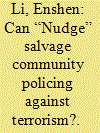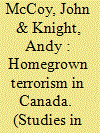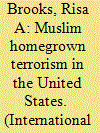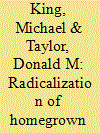|
|
|
Sort Order |
|
|
|
Items / Page
|
|
|
|
|
|
|
| Srl | Item |
| 1 |
ID:
190907


|
|
|
|
|
| Summary/Abstract |
Since the mid-2000s, the fear of “homegrown” terrorism in most developed democracies has prodded police to partner with local Muslim communities as a proactive and preventive approach to Islamic extremism. However, despite practical variations, this model of counterterrorism community policing (“CTCP”) has faced a comparable challenge—the lack of legal and moral legitimacy within counterterrorism law enforcement which erodes Muslim communities’ trust and confidence in policing. Drawing on common critiques of CTCP in the U.S., the U.K. and Australia, this article aims to proffer a behavioral-economics view to promote intended goals of CTCP. Borrowing the ideas of Nudge Theory, my discussion suggests that community engagement within CTCP could be stimulated more effectively through a subtle process of trust building whereby residents are coaxed toward cooperation through indirect encouragement, assistance and facilitation. Through a case study of CTCP in Muslim communities, it is argued that nudge entails the refrainment of the political and media narrative from conflating Islamist ideology with the prime source of domestic terrorist danger. At the grassroots level, the nudge-oriented CTCP is contingent upon community representatives taking on a more active and forefront role in CTCP with police reducing their visibility to only facilitate in the background.
|
|
|
|
|
|
|
|
|
|
|
|
|
|
|
|
| 2 |
ID:
144864


|
|
|
|
|
| Summary/Abstract |
This article examines how the phenomenon of homegrown terrorism has evolved over the past decade. It argues that there have been significant developments that impact how we conceptualize and study it and offers two suggestions moving forward. It argues that re-branding it Islamist-inspired homegrown terrorism (IIHGT) better captures the nuances of this phenomenon and that sub-dividing it by “endgame,” the action the radicalized individual pursues creates the opportunity for a more robust analysis and provides a better way to compare incidents and identify traits that our current efforts overlook. Focusing on the action component may also provide a new way to investigate radicalization as the different endgames represent an escalation in violence, suggesting different degrees of radicalization might also be present.
|
|
|
|
|
|
|
|
|
|
|
|
|
|
|
|
| 3 |
ID:
095807


|
|
|
|
|
| Publication |
2010.
|
| Summary/Abstract |
Since 2001, a preponderance of terrorist activity in Europe, North America, and Australia, has involved radicalized Westerners inspired by al Qaeda. Described as 'homegrown terrorism', perpetrators are citizens and residents born, raised, and educated within the countries they attack. While most scholars and policy-makers agree that radicalization plays a central role in persuading Westerners to embrace terrorism, little research properly investigates the internal and cognitive processes inherent to radicalization. Transformative learning theory, developed from the sciences in education, health, and rehabilitation, provides an unconventional and interdisciplinary way to understand the radicalization process. The theory suggests that sustained behavioural change can occur when critical reflection and the development of novel personal belief systems are provoked by specific triggering factors. In applying transformative learning theory to homegrown terrorism, this study helps explain how formerly non-violent individuals come to condone, legitimize, and participate in violent behaviour.
|
|
|
|
|
|
|
|
|
|
|
|
|
|
|
|
| 4 |
ID:
137793


|
|
|
|
|
| Summary/Abstract |
The article examines how global trends related to militant Islamism have influenced patterns of homegrown terrorism in Canada. It seeks to understand how an evolving movement has shaped three case studies, two cases of homegrown terrorism, the case of Momin Khawaja, the “Toronto 18” plot, and the emerging trend of extremist travelers. Recognizing the notable gap in the literature, a growing number of cases of homegrown terrorism and extremism in Canada suggest that further study is required. The article asks why Canadians choose to participate in this movement and why militant Islamist movements are actively recruiting them.
|
|
|
|
|
|
|
|
|
|
|
|
|
|
|
|
| 5 |
ID:
107648


|
|
|
|
|
| Publication |
2011.
|
| Summary/Abstract |
Since the September 11 attacks, analysts and public officials have expressed growing concern about the potential of Muslim citizens and residents of the United States to plot attacks within the country's borders-a phenomenon sometimes referred to as "homegrown" terrorism. To assess this apparent threat, it is necessary to examine what is known about the willingness and capacity of Muslim Americans to execute deadly attacks in the United States. Three conditions, either alone or together, could contribute to an increasing threat of homegrown terrorism. The first concerns what is known about the radicalization of Muslim Americans and whether a surge in arrests in 2009 indicates a growing trend in Muslim American terrorism. The second relates to the capacity of aspiring militants to avoid detection as they prepare attacks. The third depends on the skills of aspiring terrorists and therefore their capacities to execute increasingly sophisticated attacks. The analysis should be generally reassuring to those concerned about Muslim homegrown terrorism. On both analytical and empirical grounds, there is not a significant basis for anticipating that Muslim Americans are increasingly motivated or capable of successfully engaging in lethal terrorist attacks in the United States.
|
|
|
|
|
|
|
|
|
|
|
|
|
|
|
|
| 6 |
ID:
109787


|
|
|
|
|
| Publication |
2011.
|
| Summary/Abstract |
This article attempts to consolidate theorizing about the radicalization of Western homegrown jihadists. Five major models of radicalization are reviewed. The commonalities and discrepancies among these models are identified and analyzed in the context of empirical evidence in the field of terrorism research and social psychology. Three psychological factors emerge as contributors to radicalization: group relative deprivation, identity conflicts, and personality characteristics. Avenues for future research concerning the radicalization of homegrown jihadists are suggested, focusing on research that may not only be practical for counter-terrorism, but also feasible given the challenges of research with radicalized individuals.
|
|
|
|
|
|
|
|
|
|
|
|
|
|
|
|
|
|
|
|
|